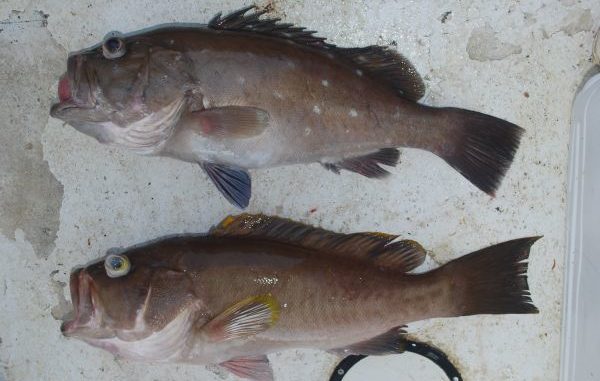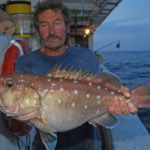
And they’re easy to catch, too
Everybody, and I mean everybody who fishes, offshore loves groupers. They are attractive fish, resembling overgrown and (usually) more colorful largemouth bass. They are brutal fighters when hooked on tackle that isn’t too heavy.
Best of all they are great to eat.
Forty species of groupers exist off North American coasts, and 23 of these are found in the Gulf and Atlantic.
One of the common but lesser-known species in the Gulf of Mexico is the snowy grouper (Hyporthodus niveatus).
Snowy groupers not caught as often as gag and scamp groupers because they are a “deepwater” species. Gag and scamp are most often caught at the same depths as red snappers, which means less than 250 feet deep.
Snowies are seldom caught shallower than 300 feet, where they often turn up in commercial reef fishermen’s catches.
They often call the fish “brownies.” It’s easy to see why.
Its background body color is a brown, shading from chocolate on its back to silvery light brown below.
One of the characteristics of snowy grouper are it’s white polka dots set in five or six vertical rows on the sides of the fish.
On small and medium fish (up to 30 pounds), the dots are distinct against the brown background color. However, as the fish gets older and larger the dots begin to fade out, and on very large individuals they might disappear.
Most fisheries identification guides list the fish as difficult to identify because of its resemblance to two other deepwater groupers: the yellowedge and the warsaw.
Yellowedge groupers add to confusion in identification because quite often small specimens (less than 5 pounds) carry identical polka dots.
However, yellowedges always have wide, bright-yellow margins on their pectoral, dorsal and anal fins; snowies never do.
As for separating snowy groupers from warsaws, a quick check of the heavy, sharp spines of the dorsal fin will give the two away. Snowies have 11 of them, while warsaws have 10. Additionally, the spines of the warsaw’s fin are very long and prominent, having the appearance of a rooster’s comb.
Brownies will grow to 65 pounds, half again larger than yellowedge groupers but much smaller than the maximum size for warsaw groupers.
Brownies appear to segregate themselves by size, with the largest fish living in the deepest waters (300 to 1,600 feet) and the smallest fish living in the shallowest depths (occasionally as shallow as 150 feet).
They grow slowly but consistently for the first 15 years of their lives, until they reach about 40 inches long; then growth slows even more for the rest of their lives.
Most studies list 29 years as their maximum life span although recent research found a snowy grouper 44 years old.
Brownies in the Gulf of Mexico spawn from April to October. The fertilized eggs and newly hatched larvae are pelagic, meaning they drift at the mercy of water currents.
By 2 years old, they have grown to between 9 and 10 inches long, and will occasionally be caught on hooks.
They are bold, aggressive predators that are not hook-shy, a trait which has gotten them in trouble in part of their range.
Snowy groupers are found from Massachusetts southward along the coast through the entire Gulf of Mexico and the Caribbean down to southern Brazil.
Within the U.S. part of their range, they receive the most fishing pressure off of the coasts of the Carolinas, where both recreational and commercial fishermen target them.
One study conducted off of North Carolina was done on an area of good snowy grouper bottom that had not been fished before. In this study area, fishermen were able to catch 3 percent of the population per day, until by 3 months the population was fished down to very low levels.
In other words, brownies are easy to catch.
In the Carolinas, scientists have also noted a steady decline in the average size of snowy groupers caught since the early 1980s.
Any fish population that experiences more than minimal fishing pressure will show such a decline because humans are taking fish out of the population before they can grow as large as they did when they were unfished.
At some stage, however, a continued decline in average size becomes cause for alarm. Compounding this concern is the fact that snowy groupers are protogynous hermaphrodites.
This simply means that (like most, if not all, other groupers) brownies change sex during their lives. They are all hatched and grow as females first, only later changing to males.
This gender change takes place between the ages of 6 and 13 years old and 13 to 35 inches long, depending on the individual fish. A few females mature at age 3, and half a mature by 5. By 7 years old, all are able to spawn, unless they have already changed gender.
Even in unfished populations of snowy groupers, the number of females is always larger than the number of males.
But the lopsided sex ratio of some fished populations is extreme. Off the Carolinas, the percentage of males has declined from 7 to 23 percent (depending on the study) of the population in the 1970s to 1 percent in the 1990s.
Because male grouper are larger and more aggressive than females, they often beat females to the bait and are the first fish caught.
Adding to the concern in the study was the fact that more than 50 percent of the females in the catch were immature, never having spawned.
Brownies live in waters too deep and cold for coral reef growth, but they seem to prefer rough bottoms with rocky outcrops, often swept by strong currents.
Their depth range largely overlaps that of their close relative the yellowedge grouper, but the yellowedge seems to prefer more-open hard bottoms.
In the Gulf, the rocky ridges preferred by snowy groupers are very often interspersed with areas of firm clay bottoms, ideal habitat for golden tilefish. Both species dine on many of the same foods.
One study showed fish as their No. 1 food item; another showed deepwater crabs as being, by far, the most common food eaten, especially by larger groupers.
Butterfish and several species of eels are common fishes in their diets. Besides fish and crabs, snowy groupers also consume substantial numbers of squid, and some snails and deepwater shrimp.




